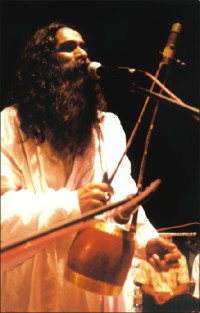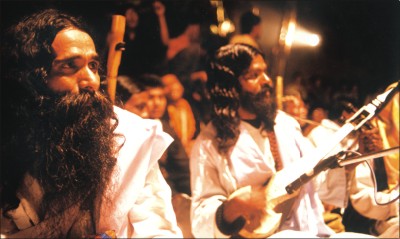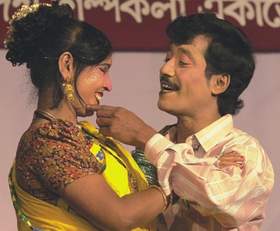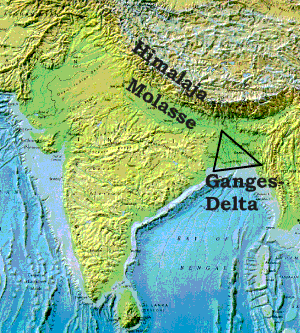Traditional Social Dynamics in Bangladesh
CONTENT
- 1. INTRODUCTION
- 2. Bengali Language
- 3. The Ganges-Brahmaputra Delta
1. INTRODUCTION
Traditionally this country lived with harmony to nature which reflects in ancient boul, Murshidi, Jari, Bhatiali songs. Bangladesh has developed over the centuries an excellent social situation based on humanism and secular thought - a very modern trend of social advancement Europe had known during the renaissance. Mainly four streams mingled in this social thought process - tribal anthropomorphism, Buddhist nihilism, Hindu vaiishnavism and Muslim sufism. These four historical forces plus the various local mystic cults of different obscure religious sects which cast and class distinction and autocratic establishment prompted ancient Bangladesh to develop with the hopes fought relentlessly against religious fundamentalism, orthodoxy, fanatism, crude and aspirations of the common men and their philosophy synthesis. Social dynamics of rural Bangladesh is rooted in this cultural synthesis and religious tolerance. In the 16th Century Bangladesh was the first and only country in the world that introduced religion freedom and during this time the country flourished at its highest peak. Sebastien Manrique in 1640 wrote a very impressive account of prosperity of Dhaka:Many strange nations resort to this city on account of its vast trade and commerce in a great variety of commodities, which are produced in profusion in the rich and fertile lands of these regions. These have raised the city to an eminence of wealth which is actually stupefying, especially when one sees and considers the large quantities of money, in a such quantity indeed that, being difficult to account, it used commonly to weighed.
There are many accounts and references which point out that the ancient people of Bengal were different in race, culture and language from the Aryans . The original inhabitants of Bengal were non-aryan. According to Sylvan Levi, the primitive people of Bengal spoke a language that was neither Aryan nor dravidian, but belonged to a separate family. Lying at the crossroads of South Asia and Central Asia, Bengal attracted people from early civilisation of the fertile crescent.. It is now generally held that the foundations of the agriculture-based village life, which is also believed to be one of the foundation of Indian Civilisation, were laid by the Nishadas or Auastric-speaking peoples of Bengal. It may be presumed that Bengal developed a culture of ist own which was non-Vedic and non-Aryan. It is true that Aryan culture, and the Vedic, Buddhist and Jaina religions influenced Bengal. The primitive culture became absorbed but it also influenced adopted religion.
History of Bengal
Bouls of Bengal
Age-old tradition of puppet theatre- A dying Art
Bangladesh is characterized by a unique coming together of many races, languages and religions. Its culture is a distinctive composite to which Jains, Buddhists, Hindus, Vaisnavas and Muslims have all contributed. From time to time Bangladesh searches for its roots as if trying to put back the missing parts in its long history. In the search for these roots we must look at its poetry.
They give us a vivid account of the life and occupations of the common people, their work, events of birth, marriage and death, religious activities, dress and ornaments, food and utensils, and music and musical instruments. There is also a beautiful description of the riverine and green eastern part of Bengal which is Bangladesh today. The poems describe rivers, canals, ponds, muddy shores, various types of boats and their different parts, ferrying, and rowing; all these were used by the siddhacaryas as spiritual symbols.
The poems describe rivers, canals, ponds, muddy shores, various types of boats and their different parts, ferrying, and rowing; all these were used by the siddhacaryas as spiritual symbols.
The Bengali siddhas, Buddhist mystics, used poetry as a vehicle for teaching one of the most difficult and mystic religious, that known as the shahajia mystic school of Buddhism. Through the use of the mother tongue of the common people, the mystic poets conveyed serious religious philosophies. The poems are a part of the cultural and religious heritage of Bangladesh, India, Nepal, Bhutan and Tibet
The Caryagiti influenced Gita-govinda, a famous Sanskrit work of the Bengali poet Jayadeva and Vaisnava Padabali, and much later, Rabindranath Tagore and the Baul songs of Bangladesh; Gita-govinda is a celebration of love between Krishna, the god of love and Radha.
Radha-Krishna - mythological traditions
Ancient history of Bengal shows that Bangladesh is the only country in the Indian-Subcontinent that accepted several religions but the root of the social philosophy was the ancient "Kuamo Society" that accepted god as a human being (Mukhopadhya, 1983). The society was based on "see" and emotional "feel" in a simple peaceful environment. These strong sustainable elements of the society can be seen as weakness as it could not resist foreign invaders (Mukhopadhya, 1983). Mainly four streams mingled in this social thought process - tribal anthropomorphism, Buddhist nihilism, Hindu vaiishnavism and Muslim sufism. Bangladeshis believe in simple life - this has been achieved through past association with Buddhism, Boishnivism, Baulism, Simplism and Sufism. Bengali Baul songs, which are considered close to Carya poems in mysticism, are a synthesis of Shaajia Buddhism, Vaisnava Shahajia and Indo-Persian Sufism. Perhaps these are the elements rooted in the nation that world-wide survey by the London School of Economics (1999) found that "Bangladeshis are the happiest nation" live on this earth .
BAULS (itinerant folk singers) have roamed this part of the horizon for thousands of years. A lifestyle matched with that of the nature, bauls move from village to village soul searching through meditation and singing. You may find a single baul in simple traditional robe walking down the earthen rural road playing an ektara (one-string instrument). He is not bothered about his survival for he knows someone somewhere in the villages will give him a shelter and the meager allocations for the day. Or sometimes you may find quite a few of them gathering somewhere and puffing their time out on ganja and music. Nowadays bauls are not often found roaming the rural roads.
Simplism is traditionally rooted in the philosophy of Baulism. Bauls' culture is not very easy to understand, as it has rather complex levels of philosophy and understanding. Though a few basic traits are common among the Bauls, they leave the regular life and embrace and live a life of harsh situations and detachments. They lead a life of self and soul searching in the mystic realm of Baul philosophy
Bauls usually roam around like free sprits, not restricting themselves to any one particular order. Though there are many sub disciplines or orders, but on the whole, they are neither Hindu nor Muslim. They belong to the wider spectrum of the Bauls, unlike the Sufi order, where there are only the Islamic mystics. Legend has it that Lalon was Hindu.
Once he was traveling to a distance, and on his way he became sick with small pox. He was looked after by an elderly Muslim couple. Instead of deserting him they took care of him. On the other side, not seeing any sign of his return, his Hindu family observed his shadha (last rites). But when Lalon returned home he was denounced even by his own family, as they feared punishment of getting outcast by the society if they had accepted Lalon. The community people said as the last rite had been observed they could not accept Lalon as a living being even if he was one. Later the elderly couple recovered Lalon and adopted him, the adopted father later became Lalon's disciple and was known as Malam Shah, while the adopted mother is buried next to Lalon in his tomb in Kushtia. This is the whole situation that moulded Lalon's life, later to influence many others.
The simple message from Baulism can unite the world - forgetting and disabeling prsent terror and material interest.
Lalon - Bauls Mysticism
Jatra, the traditional open-air folk opera of Bangladesh
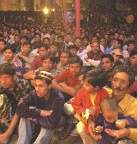
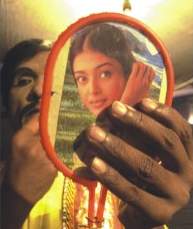
As a root of a tree are firmly buried together with the soil and its upper part is spread towards the sky, in the same way the lower part of literature is always hidden, being to a large extent imprisoned in the soil of its mother country ... there is a ceaseless inner connection between the lower literature and the higher one.
Rabinranath TagoreJatra, the traditional open-air folk opera of Bangladesh, is an integral part of folk life. There are about 210 registered Jatra Groups but every year only 50 become active. This is the only source of income for almost 4000 people, and as such around 2,00,000 people depend on Jatra. But is now going to disapper due to protest of radical religious groups and introduction of western culture through modern communication system.
The main attraction of Jatra, a loud and vigorous form of art, is the orchestra and body movements. Music and dance -- the very essence of Jatra, has gone through marked changes down the years. Dance has taken over and has now become Jatra's charm. This change has thrown aside the talent and skill of the Jatra artists. In a sense, Jatra has lost its characteristic flavour.
The entire scenario is that Bengali art is losing its glory with the introduction of other forms of modern art. If local art is not protected, Jatra artists will have to soon look at other ways to earn their living. It is high time the public should think of preserving, at any cost, the originality of Jatra.
2. Bengali Language
Bengali belongs to the Aryan branch of the Indo-European family of languages. It has been in existence as an independent language for more than ten centuries. It is the speech of the largest number of people in the Indo-Pakistan subcontinent.
The history of ancient Bengali is based on copper plate inscriptions and stone script findings. The oldest epigraphical record, found at Mahastangar in the Bogra district of Bangladesh is a very short inscription on stone written in Prakrit. Archaeologists believe it to have been written in the third century B.C.; the script shows the Brahmi characters of the time of Asoka. The inscription contains the word 'Pundrabardan which was a renowned Buddhist and Jain center of learning in Bengal
Bengali is derived from Magadhi Prakrit, which was the official language of the great emperor Asoka. A related dialect was used by Buddha and by Mohavira, the apostle of Jainism. In Bengal in the their of the first millennium B.C. no Aryan language was spoken but the people there had their own language and possessed great artistic skills. During the period of Asoka, the Prakritic or Magadhi form developed into Bengali. About a thousand years ago two kinds of language were apparently in use : the Sauraseni Apabramsa and the native language of Bengal, Proto-Bengali which had become Old Bengali by 1000 A.D.
The Muslim conquest of Bengal in c. A.D. 1200 introduced many Persian, Arabic and Turkish words; the Persian influence was the greatest. Later on the Portuguese, Dutch, French and English who came to India from the sixteenth century onwards also contributed to the Bengali vocabulary.
21st February is a day of pride. Yes, this is the day when the brave sons of the soil sacrificed their lives for our rights. The day has been recognised as the International Mother Language Day by UNESCO. It is due recognition to the language martyrs who will continue to inspire people around the globe in the days to come.
Ekushey is the biggest unifying factor as far as this nation is concerned. The occasion has traditionally remained above controversy, though some other days and events have been politicised or subjected to myopic interpretation by individuals or parties. Ekushey still retains its position as a unique day when the nation rose in defiance of an extremely arbitrary decision of the Pakistani rulers to impose Urdu as the state language. Its glory and role in the movement that culminated in our independence has never been questioned. In fact, the issue was settled back in the 1950's. An evil force which had used the bogey of Islam against the assertion of our cultural rights were defeated when the masses refused to accept their dictates and launched a movement to secure their linguistic and cultural freedoms.
It seems the extremist elements have decided to destroy the symbols that represent the tolerant political culture nurtured by this society over the years. There are tell-tale signs of some hidden agenda being pursued by some quarters aiming at countering all progressive and secular ideals, and Ekushey might have been targeted as part of the execution of that vicious plan.
The fanatics cannot any longer be dismissed lightly as they are showing signs of being organised and having the readiness to strike. The government must make an all-out effort to contain the challenge which is apparently growing stronger by the day in the absence of effective resistance.SUFISM
The History of Bengali LanguageTagore's views on the language (Sadler's Commission (1919))
It is Sir Rabindranath's strong conviction that, while English should be skilfully and thoroughly taught as a second language, the chief medium of instruction in schools (and even in colleges up to the stage of the university degree) should be the mother tongue. He has four reasons for this belief: first, because it is through his mother tongue that every man learns the deepest lessons of life: second, because some of those pupils who have a just claim to higher education cannot master the English language; third, because many of those who do acquire English fail to achieve true proficiency in it and yet, in the attempt to learn a language so difficult to a Bengali, spend too large a part of the energy which is indispensable to the growth of the power of independent thought and observation; and, fourth, because a training conducted chiefly through the mother tongue would lighten the load of education for girls, whose deeper culture is of high importance to India. He holds that the essential things in the culture of the West should be conveyed to the whole Bengali people by means of a widely diffused education, but that this can only be done through a wider use of the vernacular in schools.
Gandhi wrote his first major book Hind Swaraj ("Indian Home Rule") While presiding over the All-India Common Script and common language conference, insisting that Hindi should be India's common language, Gandhi said that whenever he spoke English he felt "I am committing a sin." While attending Lucknow Congress he argued that unless Congress business was conducted in Hindi, rather than English, Swaraj was not possible. "In provincial matters, the provincial languages may be used," he conceded "But national question ought to be deliberated in the national language only."
At Nagpur, Gandhi moved for adoption for new Congress creed, which changed" The object of the Indian National Congress" from "Responsible colonial Government" to "the attainment of Swaraj by the people of India by all legitimate and peaceful means," He spoke in support of his creed he had drafted in Hindi, insisting it should be Indian's national language and the language of every Congress meeting.
In the Lucknow session of the All-India Muslim League in 1936 a resolution proposing Urdu as the language of Muslim India was moved. The resolution was strongly opposed by the delegates from Bengal. On the direct intervention of Jinnah, it was ultimately resolved that "whatever Urdu language is the language of the area its unhampered development and use should be upheld, and where it is not the predominant language, adequate arrangements should be made for teaching it as an optional subject"
On 22 February 1938 Poet Sanjoy Bhattacharjee, the Editor of Purbasha wrote to Rabindra Nath Tagore bemoaning why and for what fault the well -enriched Bengali language should be deprived of the honour of being the state language of the country and requested Tagore's views on that question.
Tagore expressed his inability to protest against the decision of the Congress not to regard Bengali as the state language. He wrote back, 'The duty of Congress is in the Congress's hand. I am not even a member. If you want to strive in vain , you do. You are younger in age . You have got enough time'. Tagore never expressed any opinion to make Bengali a state language. He had little enthusiasm for that. Both Jinnah and Gandhi were of the view that in the provinces language of the provinces may be used. In all-India level Gandhi pleaded for Hindi and in Pakistan pleaded for Urdu.
Before India was partitioned All-India Congress decided on Hindi and All-India Muslim League opted for Urdu. Jinnah was a little surprised when he found his choice was opposed in Dhaka. On the question he was not at all emotional or sentimental. He did not earn much proficiency in his mother language. Both English and Urdu appear to be his acquired languages.
The people of Dhaka gave Jinnah a formal reception at the Race Course Maidan on 21 March 1948. In the afternoon that day Jinnah spoke for about an hour on language issue and the language movement. He said, "About language as I have already said , this is in order to create disruption among the Musalmans. Your Prime Minister has rightly pointed this out in a recent statement and I am glad that his government has decided to put down firmly any attempt to disturb the peace of this province by political saboteurs or their agents. Whether Bengali shall be the official language of this province is a matter of the elected representatives of the people of this province to decide. I have no doubt that this question shall be decided solely in accordance with the wishes of the inhabitants of this province at the appropriate time."
Speaking in favour of Urdu as the state language Jinnah said, "Let me tell you in the clearest language that there is no truth that your normal life is going to be touched or disturbed so far as your Bengali language is concerned. But ultimately it is for you, the people of this province, to decide what shall be the language this province. But let me tell you very clearly that the Sate Language of Pakistan is gong to be Urdu and no other language. Any one who tries to mislead you is really the enemy of Pkistan. Without one state language no nation can remain tied up solidly together and function. Look at the history of other countries. Therefore, so far as the state language is concerned, Pakistan's language shall be Urdu. But, as I have said, it will come in time".
The Language Movement of 1952 - 21 st Feberuary.
You might know that Chorjapod the most ancient evidence of Bengali literature, a two thousand-year old anthology of poetry, which was found from the library of the Royal Court of Nepal. In the ancient times the Buddhist Emperors of the Pal Dynasty patronized Bengali. But in the successive periods Bengali language had to survive the reigns of the strictly Brahmin Sen Dynasty. I said 'survived' because as a language of 'prakrito jon' or the common people Bengali had to bear the pressure of Sanskrit, the royal language of that time.
The Sen Emperors were keen to use Sanskrit as the language of the scriptures and literature. As a result Bengali was banished from the Royal Court. Bengali was banned as a language of the scriptures by a Royal Decree. But the popular language flourished among the common people.
After the Sen period, Bengali flourished in the reign of the Sultani period. In the Sultani period the rulers were sultans of Turkish origin but they were the greatest patrons of Bengali language and literature. The sultans of the Ilias Shahi and Hossain Shahi dynasties were very eager for the development of Bengali language. At this time under the patronization of the Sultans and their high officials many books including Mahabharat, Ramayan and Bhagabatgeeta were translated into Bengali from Sanskrit. As Bengali was the language of the common people when these were translated into Bengali the general populace was able to fathom the contents of the great holy books. Along with Sanskrit, Bengali became the language of the literature. Sultan Borbok Shah, Sultan Hossain Shah and Sultan Ghiasuddin Azam Shah were patrons of Bengali literature. It is said that the Turkish reign in Bengal was a boon for the Bengali literature.
However, the Pakistani period that followed, was just a facsimile of the Sen period. According to the Abdul Karim Shahitto Bisharod if the ruling class tries to ruin the language of the nation then they cannot remain in power for long. Soon after the termination of the British Raj the Pakistan Government tried abolish Bengali from the administrative language and to impose Urdu on us. Bizarre proposals like writing Bengali in the Arabic and Urdu scripts were presented to the Bengali populace.
These unwanted pressures on our mother tongue led to the Language Movement of 1952. We all know what happened on the 21st February so I will not reiterate. What we always have to know is that our language is an ancient one. It is not easy to erase a language that is two thousand years old. The apathetic Pakistani rulers forgot this but in the end they had to concede the truth and they had to accept Bengali as the state language of Pakistan. Here lies the spirit of Ekushey.
We remember 21 st February 1952
The observance of Ekushey yet once more ought to send out a message to all of us in Bangladesh. The message relates chiefly to what we, as citizens, as repositories of democratic political beliefs across the spectrum, should be doing about upholding the spirit we have come to associate with the Language Movement of 1952. The spirit, if we recall —- and recall we must —- was one geared towards a reassertion of Bengali rights and cultural values only five years into what we thought was our emergence as an independent people within the parameters of Pakistan.
As the tragedy on 21 February 1952, and the circumstances around it, were to demonstrate to us, that assessment of our being a free people was based on some rather wrong assumptions. Our faith in democracy, our belief in tradition and our loyalty to our historical values had come under assault, which is why we needed to reassert them through a massive demonstration of the popular will on the streets of Dhaka and elsewhere fifty three years ago.
The message today, therefore, is a simple and yet substantive one. It speaks of the great will and awareness of society that went into the struggle in defence of the Bengali language in 1952. But in a far bigger way, Ekushey was for us a powerful signal that as people with distinctive cultural traditions, we could not but prepare to free ourselves as a nation in the times to be. It was from such an understanding of our place in history that the nation’s political leadership initiated the movement for Bengali autonomy. The 1960s, from such a point of view, were clearly some of the more moving times in our lives. It was within this period that we were able to go into profound soul-searching, to come away with the definitive finding that in order to be able to give ourselves a political voice as a modern nation, we needed to be secular, democratic and therefore representative of all the good and decent that life in general symbolised.
It is all these qualities that we need to struggle for anew in these extremely difficult times. Let us not pretend that a mere observance of Ekushey reinforces our hold on life and on history as a whole. The rising spate of criminality around us, the endemic corruption, the gradual slide of democratic tolerance among the nation’s political parties and the overall sense of deepening despair among the one hundred and forty million people of Bangladesh are pointers to an unwelcome truth — that our aspirations towards building a just, democratic and welfare-oriented society for ourselves is yet a dream. More ominously, the dream keeps receding, to a point where we fear a nightmare of monstrous proportions could soon be upon us.
On Ekushey this year, therefore, the prayer must be one related to a forging of national unity across the frontier of political differences. We cannot forget that it was a united, unified and determined nation which went to war to free the land in 1971. With three million of our fellow Bengalis dead in the war, with two hundred thousand women molested and with thousands of villages and towns torched by the enemy and its local collaborators, we could not but go forth to build anew. For thirty four years we have been on a search to find ourselves. It will be unwise to think that we can spend an equal amount of time to consolidate ourselves as a happy, economically developed and politically mature society. On Ekushey, we ask our political leadership to recall the old spirit of 1952 and find the ways and means of rekindling it in us in these tumultuous, hugely disturbing times we live in.
The Spirit of Language Movement
Is the spirit of the ‘language movement’ of the Bengalis, beginning with a few students saying ‘no’ to governor general Mohammad Ali Jinnah’s assertion on March 24, 1948 that Urdu would be the lone official language of Pakistan and reaching climax on February 21, 1952 with the police killing Bengali students agitating for Bangla to be the national language, still relevant to the life of Bangladeshis who wrested their national independence from Jinnah’s Pakistan more than a quarter of a century ago?
The movement brewed from a grave deviation of a political principle staged by no other than the prime leader of the Pakistan movement in the mid-1940s, Mohammad Ali Jinnah. In his historic inaugural address to the Constituent Assembly of Pakistan on August 11, 1947, Jinnah promised that while running the affairs of the state, he, as the governor general of Pakistan, would ‘always be guided by the principles of justice and fair play without any, as is put in the political language, prejudice or ill will, in other words, partiality or favouritism’. ‘My guiding principle will be justice and complete impartiality,’ he announced unequivocally. The Muslims of the erstwhile East Pakistan, who actually strengthened Jinnah’s Pakistan movement by providing him with active mass support, naturally took this as assurance. But Jinnah betrayed them within no time, by way of denying the people of East Pakistan — 56 per cent of the total population of then Pakistan — their legitimate right to get Bangla, the language of the majority, graduated as an official language of the state, alongside Urdu, the language of the minority.
The language movement was a protest against this injustice, partiality and foul play by the ruling elite against the majority of the population — a phenomenon which is still there in different forms in independent Bangladesh, a phenomenon that cannot be done away with if the spirit of the language movement is not celebrated today.
Clearly, the movement was aimed at establishing the democratic right of the Bengali population, which constituted the majority of the population, while it showed political sensitivity towards the rights of the Urdu-speaking minority of then Pakistan as well
Thousands of poor people could easily identify their cultural and material interests with the essence of the movement, which was to secure, primarily, the recognition of Bangla, the language of the poor Bengali masses of the day, in the civil and judicial services, not to mention the academia.
The objective is yet to be achieved effectively, as the poor people, still the majority of the country, have not yet been able to establish a government of their own even half a century since the language movement and gaining national independence for Bangladesh in the meanwhile. The poor Bengalis, who actively supported both the language movement and the movement for national independence, still cannot understand as to what instruction a senior public servant issues on a matter of public importance, or as to what a professional lawyer argues in the high court for his/her poor clients. Is there any reason, then, to accept the proposition that the spirit of the language movement has become irrelevant these days? What is rather more important to understand in this regard is that the subsequent government leaders of Bangladesh have rather betrayed the cause of the majority of our population the same way that Jinnah did in Pakistan. Notably, the languages and cultures of Bangladesh’s ethnic minority groups are also still waiting to be officially recognised by the chauvinist Bengali ruling class.
The government leaders in independent Bangladesh seldom realise that the Bengali nation in question include millions of poor Bangladeshis too, who still do not have access to printed knowledge at all — let alone global knowledge available in foreign languages. Naturally, Bangladeshis need to revive forcefully the spirit of the language movement to make the anti-people ruling elite, apparently divided into opposing political camps, realise that the country also belong to its poor majority.Our glory is identified with global pride
The Language Movement was in effect the prelude to the liberation of Bangladesh because from it the struggle for rights and struggle against oppression started to take up steam, which ultimately led to independence struggle which had its successful culmination when on December 16th, 1971, this nation won freedom.
For a long time, it was only us who remembered the language martyrs and their selfless sacrifice that gave us the right to speak our language. But, with the world fast becoming a global village, this unique event did not take time to catch the eye of others.
Now, we celebrate 21st February as the international mother language day.
Unesco, in 1999 in Paris, in a unanimous decision declared 21st February as International Mother Language Day. All 191 UN nations around the world would celebrate their mother tongues from the year 2000 while bearing in mind that promoting the dissemination of mother tongues will serve not only to encourage linguistic diversity and multilingual education but also to develop fuller awareness about linguistic and cultural traditions throughout the world and to inspire solidarity based on understanding, tolerance and dialogue. This noble cause of unifying, while at the same time promoting diversification, comes in the form of commemorating our martyrs.
Now, in the 21st century, the diminishing trend in the use of Bangla has been fortified due to the adverse impacts of globalisation, free-market economy and information technology. The political parties here hardly did anything during the movement, as they were busy struggling for power. We have failed to imbue the minds of the masses with the spirit of the language movement, even after 35 years of independence
A nation cannot fail forever. A new generation will come up to ignite a social movement to ensure a wide use of Bangla. You should overcome whatever obstacle you face on the way to attaining the ultimate goal of a progressive, secular and prosperous Bangladesh with the spirit of the language movementGlobalisation and Culture of Third World
The onslaught of aberrant culture that does more harm than good has become the cause of concern for the people in general in this country. Numerous satellite channels have come under fire for promoting and profiting from showing low quality western and other films and drama serials targeting the young generation. They are peddling corruption in the guise of cinema and soap operas and dance and music shows Our cultural heritage is at risk through globalisation.
3. The Ganges-Brahmaputra Delta
The Ganges-Brahmaputra-Meghna delta is the largest delta in the world. The Himalayan rivers contribute one-third of the global sediment transport to the world oceans (Millman et al., 1983). Since millions of years the Bengal basin received millions of flood that created this land to the present form. With the birth of the modern Himalayan Mountains about 35 million years ago the mighty rivers drained along paleoslopes and deposited about 16-18 kilometres of thick sediments in Bangladesh. The ancient river records of this region show several overflows of the channels during the period of high discharge. Sediments of the confluent Ganges-Brahmaputra-Meghna rivers are today deposited predominantly in the huge sub-aerial delta of these rivers, but during lowered sea levels of the geological past they poured largely into largely in the submarine canyon in the east . The shifting of submarine canyons and deep-sea fans from east to west since 75 million years is one of the remarkable features.
The rivers deposited sediments as active river flood plains, braided flood plains, meander flood plains, major flood plain basins, estuarine flood plains, tidal flood plains and deep sea fans. The Ganges-Brahmaputra river system, the second largest river system of the world, anticipates special significance:
- The existing gradient between the sources of these rivers and the river mouth;
- Deforestation in the drainage areas;
- Their direct connection to the deep sea via canyons and a network of submarine channels
Floodplain gradients are low. The average gradient from the north-western tip to the coast is less than 20 centimetres per kilometre south of Dhaka, the gradient averages only 1.6, whereas the general direction of groundwater flow is towards the Bay of Bengal, with gradient varying from 1:1,000 in NW to 1:13,000 in the central Bangladesh and less than 1:20,000 in Coastal areas).
Tragedy in the Himalays and Ganges-Brahmaputra Plain - Flood, drought, earthquake and cyclone
(Last Modified: June 20, 2015)Top of Page
Women Project
Introduction.
Home.

